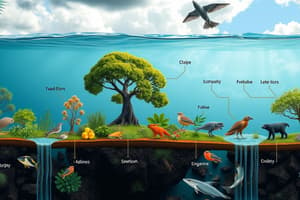Podcast
Questions and Answers
What does an inverted pyramid of numbers indicate in an ecosystem?
What does an inverted pyramid of numbers indicate in an ecosystem?
- A large number of primary consumers feeding on a single producer. (correct)
- A balanced ecosystem with diverse species.
- An even distribution of energy among trophic levels.
- A large number of producers feeding on few consumers.
Which statement about pyramids of energy is true?
Which statement about pyramids of energy is true?
- They illustrate the possibility of energy loss at lower levels.
- They will always be upright, indicating more energy at lower levels.
- They can occasionally be inverted without consequence.
- They accurately represent energy transfer between any two levels. (correct)
How can human activities affect ecosystems?
How can human activities affect ecosystems?
- They often result in permanent changes in populations. (correct)
- They have no significant impact on energy flow in ecosystems.
- They always lead to better growth of diverse species.
- They only impact species at the top of the food chain.
What is a key characteristic of monocultures?
What is a key characteristic of monocultures?
What is a consequence of reduced biodiversity in an ecosystem?
What is a consequence of reduced biodiversity in an ecosystem?
Why are nutrient-poor soils of tropical rainforests unsuitable for cereal grains?
Why are nutrient-poor soils of tropical rainforests unsuitable for cereal grains?
How does the energy flow through ecosystems relate to food chain size?
How does the energy flow through ecosystems relate to food chain size?
What happens to energy if producers are affected in an ecosystem?
What happens to energy if producers are affected in an ecosystem?
What is the primary function of producers in the energy flow within ecosystems?
What is the primary function of producers in the energy flow within ecosystems?
Which of the following accurately describes food chains?
Which of the following accurately describes food chains?
What percentage of energy is typically passed from one trophic level to the next?
What percentage of energy is typically passed from one trophic level to the next?
Which ecological pyramid represents the distribution of energy within an ecosystem?
Which ecological pyramid represents the distribution of energy within an ecosystem?
In a pyramid of numbers, what does the width of each bar represent?
In a pyramid of numbers, what does the width of each bar represent?
What is a characteristic feature of food webs compared to food chains?
What is a characteristic feature of food webs compared to food chains?
What happens to the majority of energy that is not transferred to the next trophic level?
What happens to the majority of energy that is not transferred to the next trophic level?
Which type of ecosystem might exhibit an inverted pyramid of biomass?
Which type of ecosystem might exhibit an inverted pyramid of biomass?
Flashcards
Food Chain
Food Chain
A model showing the linear pathway of energy flow in ecosystems.
Food Web
Food Web
A model depicting connections between different food chains, showing more accurate energy transfer.
Trophic Levels
Trophic Levels
Steps in a food chain or web, representing different feeding relationships.
Energy Transfer (between trophic levels)
Energy Transfer (between trophic levels)
Signup and view all the flashcards
Pyramid of Energy
Pyramid of Energy
Signup and view all the flashcards
Pyramid of Numbers
Pyramid of Numbers
Signup and view all the flashcards
Pyramid of Biomass
Pyramid of Biomass
Signup and view all the flashcards
Rule of 10
Rule of 10
Signup and view all the flashcards
Inverted Pyramid
Inverted Pyramid
Signup and view all the flashcards
Human Energy Use
Human Energy Use
Signup and view all the flashcards
Energy Transfer & Ecosystem Stability
Energy Transfer & Ecosystem Stability
Signup and view all the flashcards
Monoculture
Monoculture
Signup and view all the flashcards
Biodiversity and Monocultures
Biodiversity and Monocultures
Signup and view all the flashcards
Ecosystem Fragility
Ecosystem Fragility
Signup and view all the flashcards
Study Notes
Energy Flow Through the Biosphere
- Energy flows through trophic levels in ecosystems.
- Producers, like plants, capture energy from the sun.
- Consumers, like animals, obtain energy by consuming other organisms.
- Energy flow is not 100% efficient.
- Only about 5-20% of energy is transferred between trophic levels.
- The rest is lost as heat.
- Food chains model linear energy pathways.
- Food webs show interconnected food chains.
- Food webs are more accurate representations of ecosystem energy flows.
- Arrows in food webs point toward the direction of energy flow.
- Ecological pyramids depict the distribution of energy, biomass, or numbers in an ecosystem.
- Pyramids of energy, numbers, and biomass are all ways to quantify energy flow.
- Pyramid of Numbers shows relative numbers of organisms at each trophic level.
- Producers usually outnumber consumers.
- Pyramid of Biomass shows the dry mass of living organisms per unit area at each trophic level.
- A pyramid of biomass may be inverted in some ecosystems.
- Pyramid of Energy shows the energy transferred through each trophic level.
- Pyramids of energy are always upright and depict why food chains are restricted in size.
- Humans use energy in ecosystems, impacting energy flows and ecosystem stability.
- Human activities like harvesting, hunting, and agriculture affect ecosystems.
- Climate change affects the distribution of organisms in ecosystems.
- Ecosystem stability is impacted by changes to producer populations.
- Monoculture farming practices disrupt natural cycles in tropical rainforests, causing biodiversity loss.
- Tropical rainforests are crucial for biodiversity, but monoculture practices can have negative consequences.
- Nutrient-poor soils of tropical rainforests are not suitable for many cereal grains.
Studying That Suits You
Use AI to generate personalized quizzes and flashcards to suit your learning preferences.
Related Documents
Description
This quiz covers the intricate dynamics of energy flow within the biosphere, focusing on the roles of producers and consumers. Learn how energy is transferred through trophic levels, and understand the significance of food chains and food webs in depicting these relationships. Explore concepts like ecological pyramids and their importance in quantifying energy flow.




